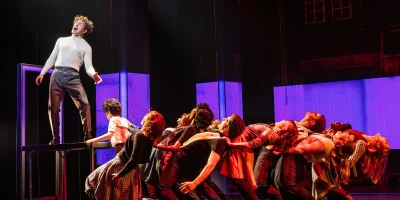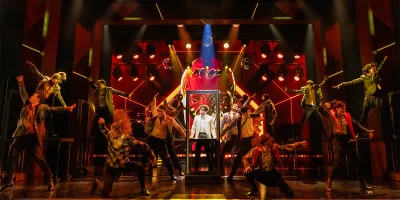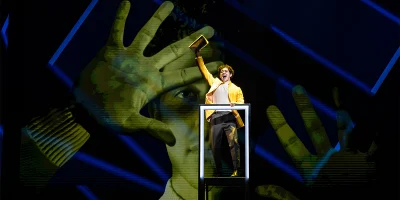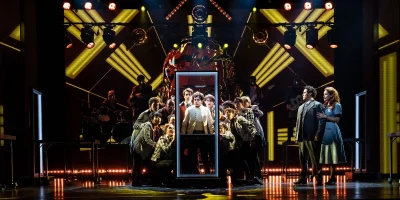
10 fun facts about 'The Who's Tommy' on Broadway
The Tony Award-nominated revival of The Who's rock opera features a futuristic aesthetic and modern design and performances that tell a timeless story.
The first revival of The Who's Tommy on Broadway guarantees that audiences have plenty to see and feel at every moment. Under the direction of Des McAnuff and with a dynamic company of designers and performers, Tommy fires on all cylinders for the entirety of its 2-hour, 10-minute run time.
"You're in for sensory overload," said cast member Bobby Conte, who plays the title character's Cousin Kevin. "If you want to feel as much as you can coming to the theatre, you've got to come see this show."
Created as an album by British rock band The Who in 1969, Tommy tells the story of a boy who loses his senses due to trauma, discovers his hidden knack for pinball, and becomes a spiritual leader — all on the road to healing.
If you've never experienced Tommy — either via stage, the 1975 film, or the original album — or even if you have, you might not know where to look or listen during this bustling new production.
"The set, lighting, costume, sound, projections — it's all one thing," said set designer David Korins. "It's impossible to know where one department starts and one department ends up."
To help guide audiences on the amazing journey, The Who's Tommy's cast and creative team shared fun facts, historical insights, and Easter eggs to watch for at the Nederlander Theatre.
Read them below, and check out our guide to The Who's Tommy on Broadway for more information about the show's plot, performance schedule, songs, and history.
The Tommy Broadway cast includes many fresh faces.
Playing the title role is 24-year-old Broadway newcomer Ali Louis Bourzgui, who won a Theatre World Award and earned Outer Critics Circle, Drama League, and Dorian Award nominations (plus widespread critical acclaim) for his performance. Not to mention, all that happened after he won a Jeff Award in Chicago for leading Tommy's pre-Broadway run there. But he's not the only cast member making their first mark on Broadway.
"[Half the cast] are making their Broadway debuts, living in New York City for the first time," Conte said. "[It] creates an energy in the theatre that is palpable."
Old songs get new life on stage.
"Listen for that guitar line throughout the show," said choreographer Lorin Latarro. "It's absolutely incredible."
One would expect nothing less from a show based on a rock album. Now-iconic songs from that record like "Pinball Wizard," "I'm Free," "Sensation," "We're Not Gonna Take It," and "See Me, Feel Me" all appear in the stage show, played live by a thunderous rock band.
"If you go back and listen to that original album, and then you listen to the album of the original Broadway cast in 1993, it's very similar, which is awesome," said ensemble member Nathan Lucrezio. "You feel like you're at a rock concert. You're going to have that same experience you would have had in the '60s and the '70s."

Tommy is considered the first rock opera.
The word "opera" usually makes people think of classical music, but "opera" can describe a sung-through narrative in any music genre. In releasing the Tommy album, The Who created the first rock opera.
"This form was created by rock stars that wanted to be in the theatrical medium," said John d'Ambrosino, who plays Uncle Ernie. "This form changed musical theatre when it first happened."
Future rock operas, like 1971's Jesus Christ Superstar, became possible thanks to Tommy. The marriage of the classical opera format with the more modern rock genre makes Tommy — or any rock opera — a great intro to theatre for music lovers.
Tommy blends new technology and old-fashioned stage magic.
McAnuff also directed the original Tommy Broadway premiere in 1993, but the show looked different back then. This production makes heavy use of LED lights and projections that add a cutting-edge, cinematic element, said ensemble member David Paul Kidder.
"[This revival] is utilizing technology that simply did not exist 30 years ago," Conte added.
But just as the show itself spans the 1940s to the future, the design also includes some old-fashioned elements alongside the new tech. Instead of using machines to move set pieces or actors, performers do almost all of that manually. They dress in all-black "transition suits" to blend into the background.
"We're moving a lot of the scenery, we're lifting other actors, and sometimes you don't see us because of the lighting design," ensemble member Reagan Pender said. See if you can spot them!

Tommy is a timeless story about leadership.
After Tommy achieves pinball fame and regains his senses, people believe his experiences made him enlightened. Soon, he's thrust into fame as an almost cultish spiritual leader.
"Tommy is a charismatic leader, and he recognizes the danger in that power of leading people off a cliff, so he insists on stepping back," Des McAnuff said. "John Lennon once did that in stepping back from fame."
Ironically, an adult Tommy also acts as a kind of spiritual guide for his younger self throughout the show. As though it really was possible to go back and speak to your younger self, he watches over and sings to little Tommy, sharing his thoughts with the audience since the child cannot.
Tommy uses nontraditional storytelling methods.
The story of Tommy is larger than life — where else would a boy would become a local pinball celebrity and then a cult leader? — and told in a unique, sung-through rock style. This isn't your traditional musical, so you'll need an open mind.
"Don't come in with a linear, conventional way of thinking," said Christina Sajous, who plays the Acid Queen. "Allow yourself to have imagination... and let it be an immersive experience."

They sure dance a mean pinball.
Latarro's choreography for Tommy elevates the experience of the show beyond simply listening to the album. For example, the most iconic song gets a clever twist.
"During 'Pinball [Wizard],' we are fully in a pinball machine as we're in the number," said ensemble member Alexandra Matteo. As the cast dances, "if you look at it visually, it looks like we're the little balls bouncing around." Shiny silver costumes intensify that effect.
Audiences see the world through Tommy's eyes.
"See me, feel me," Tommy sings — and the audience kind of gets to. The show opens with an adult Tommy putting on a silver mask that obscures his face, and a crowd of his devotees follows suit. Supposedly, they're experiencing what it was like for him to be nearly deaf, blind, and speechless.
But pay attention as the show continues: You'll see those masks pop up throughout Tommy's childhood, when his senses are impaired.
"Anytime we wear those silver pinball head-type things, it's what Tommy is seeing," said ensemble member Daniel Quadrino. "He's only seeing silhouettes... we're seeing what he sees."

Color your thoughts.
In the original 1993 production, yellow was Tommy's signature color, and it is in this version, too. But that's not the only color that stands out against the minimalist, grayscale set.
"Pay close attention to the color palette, not only of everyone's costumes, but about how all the props and colors and items, in the moment of Tommy's trauma [...] are utilized throughout the entirety of the show," Conte said. "It's ingenious."
"The designers have worked together to create a black box, a sort of open canvas," added Bourzgui. "There's certain pops of color, and every single choice of color is very specific... You can create your own ideas [of what they mean]."
A cast member performs a feat of strength.
Don't worry, this isn't a spoiler — it takes place within the first 10 minutes of the show. Tommy's dad, an army captain, is presumed killed in action, so Tommy's mom eventually takes a new lover. And then Captain Walker comes home.
"I'm the lover, and the lover accidentally gets shot," Lucrezio said. "One thing you should look out for is my breathing. You'll notice that I do not [manually] breathe when I'm dead for about 15 minutes on that stage!"
Talk about a sensation.
Photo credit: The Who's Tommy on Broadway. (Photo by Matthew Murphy and Evan Zimmerman)
Frequently asked questions
What is The Who's TOMMY on Broadway about?
The five-time Tony Award-winning rock sensation returns to Broadway. Pete Townshend and Des McAnuff's musical, inspired by the landmark album by The Who, tells the story of a catatonic boy-turned-pinball wizard with iconic songs like "We're Not Gonna Take It" and "I'm Free."
Where is The Who's TOMMY on Broadway playing?
The Who's TOMMY on Broadway is playing at Nederlander Theatre. The theatre is located at 208 West 41st Street (between 7th and 8th Avenue), New York, 10036.
How long is The Who's TOMMY on Broadway?
The running time of The Who's TOMMY on Broadway is 2hr 10min. Incl. 15min intermission.
How do you book tickets for The Who's TOMMY on Broadway?
Book tickets for The Who's TOMMY on Broadway on New York Theatre Guide.
What's the age requirement for The Who's TOMMY on Broadway?
The recommended age for The Who's TOMMY on Broadway is Ages 10+. Children under 4 years old will not be admitted..
Who wrote The Who's Tommy?
Pete Townshend (book, music, and lyrics) and Des McAnuff (book) wrote The Who's Tommy. Townshend is the co-founder, lead songwriter, guitarist, and vocalist for The Who, and McAnuff is a 10-time Tony Award winner who also directs Tommy.
Who directed The Who's Tommy?
Des McAnuff directs the Broadway revival of The Who's Tommy after winning a Tony Award for directing the original 1993 production. He also co-wrote the script with Pete Townshend.
What are the songs in The Who's Tommy?
The songs in The Who's Tommy include "Pinball Wizard," "See Me, Feel Me," "We're Not Gonna Take It," "The Acid Queen," and "I'm Free." Most of the musical's songs are pulled from the 1969 album of the same name by The Who.
Is The Who's Tommy musical the same as the album?
Yes, The Who's Tommy musical is largely the same as the album. The story of Tommy, told through the songs, is the same, and all the most famous songs from the album are in the show. However, Pete Townshend rewrote and reordered some of the songs for the stage show.
Is The Who's Tommy appropriate for kids?
The Who's Tommy is recommended for audiences 16 and older due to themes of bullying, war, and physical, sexual, and substance abuse. Please note that children 4 and younger are not permitted in Broadway theatres.
Is The Who's Tommy a true story?
No, The Who's Tommy is a completely fictional story. Real-life spiritual leader Meher Baba inspired Pete Townshend to write the songs, but none of the characters and events in the story of Tommy are real.
When was The Who's Tommy released?
The Who's Tommy album came out in 1969, and the film version followed in 1975. The Who's Tommy musical premiered on Broadway in 1993, and the current revival debuted in Chicago in 2023 before coming to Broadway in 2024.
Is The Who's Tommy good?
Yes — The Who's Tommy features time-honored songs by a globally bestselling band and a celebrated director who won a Tony for staging the show's premiere, and critical acclaim from the show's pre-Broadway run in Chicago. All these elements make Tommy one of the most talked-about revivals of the season.
Originally published on




